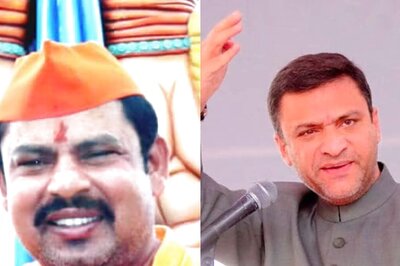
views
Only 22% of India’s rural population own life insurance products, compared to 73% across urban India. The low uptake can be primarily attributed to inadequate funds to buy life insurance (41%), high premiums (32%), and multiple buying formalities (24%), said a new report by Max Life.
Max Life Insurance Company (Max Life) has unveiled the findings of a first-ever rural edition of its flagship survey India Protection Quotient survey (IPQ) conducted in partnership with KANTAR, the marketing data and analytics company.
As per the India Protection Quotient survey, conducted across 113 villages, rural India scored 12 points on the protection quotient scale, compared to 43 points achieved by urban India in IPQ 5.0 (conducted in Nov – Dec’22). Read more
The survey revealed insights into the financial preparedness of India’s rural population, shedding light on gaps seen between the urban and rural regions of the country, and the opportunities for boosting financial preparedness across the heartland.
According to the findings, the Knowledge Index in rural India stands at 27, even as a higher sense of financial security (38%) prevails. While saving for children’s education and marriage emerged as top savings objectives, multiple anxieties around savings and expenditures for the future abound.
In the survey, 3 in 4 participants expressed concern over the depletion of their savings over the next ten years, while 1 in 4 was unsure about the savings corpus needed for the future.
Prashant Tripathy, MD and CEO, Max Life, said, “India is taking positive strides towards more inclusive development, and the focus on building the rural economy is becoming more imperative. We took our established IPQ study to 113 villages to understand how rural India plans its finances.”
“While the life insurance penetration in India remains low, this study has helped in identifying the gaps and opportunities for the life insurance ecosystem, and avenues to collectively work towards creating a systematic, scalable, multi-pronged approach that can empower the rural people to achieve their financial aspirations,” Tripathy added.
The following findings reveal rural India’s financial protection state and provide insights into its priorities and anxieties.
Financial Preparedness Of Rural Indians
Long journey ahead for rural India: Survey reveals stark urban-rural divide
The survey has shed light on a crucial issue plaguing the nation – the urban-rural divide. The findings reveal that rural India has a significantly lower score of 12 points on the Protection Quotient scale, as compared to urban India’s score of 43, indicating huge opportunity areas in enabling financial protection. This disparity also highlights the urgent need to empower rural India’s households to become better financially prepared.
While the government push for ‘Insurance-for-All’ via schemes like Pradhan Mantri Jeevan Jyoti Bima Yojana (PMJJBY), Saral Jeevan Bima, and Pension Yojana, amongst others, and the same have seen greater success, it is via an effective public-private partnership that life insurance penetration can be enhanced in the country.
Rural India struggles across metrics of financial production: Large gap in awareness and ownership of life insurance products
The survey has highlighted that with a Knowledge Index of 27, rural Indians are less aware of life insurance products, while urban India’s Knowledge Index was more than double at 57.
However, the gap in financial security between urban and rural India was not as stark as other metrics, with security levels in rural India at 38% as opposed to 63% for urban India, indicating a respectable security outlook across the country.
Outlook Towards Financial Protection
Barriers to financial protection: High premiums and inadequate funds to invest in life insurance products
As per the survey, nearly half of rural India’s respondents expressed concern over insufficient funds to purchase life insurance products. On the other hand, 1 in 3 cited ‘high premiums’ as a significant barrier in life insurance purchase, and 1 out 4 respondents felt that the purchase process is cumbersome with multiple formalities. Similarly, 2 in 5 said they have not thought of buying life insurance to financially protect their families.
Rural India prefers savings products over term plans; however, the ownership of both savings and term plans alarmingly low
Consistent with the national trend of prioritising savings over protection, rural households prefer savings instruments over term insurance plans. The awareness of savings and term plans was almost at par with 31% and 32%, respectively. However, the low ownership of savings products (9%) and term plans (12%) emerged as a cause for concern, showcasing an urgent need to bring in suitable products to enhance life insurance penetration in the country.
Savings And Spending Patterns
Rural India’s savings mindset: Preference for traditional asset classes like gold and fixed deposits becomes evident; Savings goals like kids’ education and retirement gain focus
The survey has revealed rural India’s inclination to invest in traditional financial products such as gold and fixed deposits. Heartening to know is that 83% of respondents are aware of government-backed schemes.
Aligning with their commitment to saving for their families’ futures, 64% of India’s rural population showcased an inclination to save for their children’s education, while 41% cited kids’ marriage as a savings imperative.
Basic household expenses take up majority of Rural India’s earnings
Rural India spends a major chunk of their income on basic expenditures with negligible allocation towards other discretionary expenses. The saving and spending pattern of rural India is different from urban India’s saving and expense allocation.
While rural Indians divert 55% of their earnings towards basic expenses, urban India allocates only 42% towards this non-discretionary category. Conversely, luxury expenses take up 15% of the urban Indian’s income, while rural Indians only allocate 5% for such expenses. The gap in saving and investment remains low with urban and rural India allocating 43% and 39% of their earnings, respectively towards this spending class.
Rural India’s anxieties towards increasing expenses and lowered savings
Anxieties surrounding the rapid depletion of savings remained consistent across rural India, with 3 in 4 respondents expressing concern about their savings diminishing in the next ten years.
The survey has revealed that 6 out of 10 in rural India have started to cut down their expenses to keep up with rising prices, while 1 out of 2 is unable to manage daily expenses. Additionally, 1 out of 4 respondents were unsure about the corpus of savings needed for the future.
Rapid Digitisation Powering Emergence On New India
Rural India is accessing the world from the comfort of their homes
In a positive, the survey reveals that rural India is accessing the world by leveraging technology from the comfort of their homes, with 64% of rural respondents using mobile phones for engaging in social media messaging/chatting and 58% using phones to watch movies or videos.
However, only 17% use phones for online financial transactions, highlighting that better measures are needed to build digital financial awareness and uptake in India’s rural regions.
Instituted in 2019, India Protection Quotient is an annual survey by Max Life in association with Kantar aimed to understand the pulse of the Indian consumers in the financial protection space.
Read all the Latest Business News here



















Comments
0 comment